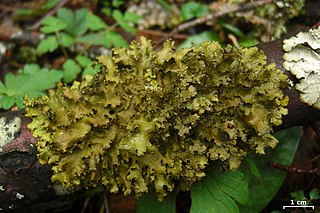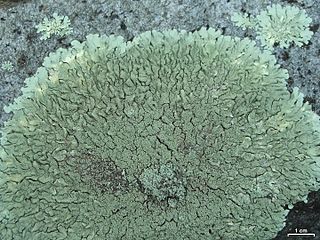
The Parmeliaceae is a large and diverse family of Lecanoromycetes. With over 2700 species in 71 genera, it is the largest family of lichen-forming fungi. The most speciose genera in the family are the well-known groups: Xanthoparmelia, Usnea, Parmotrema, and Hypotrachyna.

Vulpinic acid is a natural product first found in and important in the symbiosis underlying the biology of lichens. It is a simple methyl ester derivative of its parent compound, pulvinic acid, and a close relative of pulvinone, both of which derive from aromatic amino acids such as phenylalanine via secondary metabolism. The roles of vulpinic acid are not fully established, but may include properties that make it an antifeedant for herbivores. The compound is relatively toxic to mammals.

Letharia vulpina, commonly known as the wolf lichen, is a fruticose lichenized species of fungus in the family Parmeliaceae. It is bright yellow-green, shrubby and highly branched, and grows on the bark of living and dead conifers in parts of western and continental Europe and the Pacific Northwest and northern Rocky Mountains of North America. This species is somewhat toxic to mammals due to the yellow pigment vulpinic acid, and has been used historically as a poison for wolves and foxes. It has also been used traditionally by many native North American ethnic groups as a pigment source for dyes and paints.

Ahtiana is a genus of lichenized fungi known as candlewax lichens in the family Parmeliaceae. A monotypic genus, it contains the single species Ahtiana sphaerosporella or the mountain candlewax lichen, found in western North America. This species was segregated from the genus Parmelia by Canadian lichenologist Trevor Goward in a 1985 publication. It had been suggested that the genus include A. aurescens and A. pallidula based on similarities in morphology, but this transfer is not supported by molecular analysis.

Allocetraria is a genus of lichenized fungi in the family Parmeliaceae. It consists of 12 species, with a center of distribution in China.

Cetrariella is a genus of foliose lichens in the family Parmeliaceae. It contains three species.
Cetreliopsis is a genus of four species of lichens in the family Parmeliaceae.

Tuckermannopsis is a genus of foliose lichens in the family Parmeliaceae.

Cetrelia is a genus of leafy lichens in the large family Parmeliaceae. They are commonly known as sea-storm lichens, alluding to the wavy appearance of their lobes. The name of the genus, circumscribed in 1968 by the husband and wife lichenologists William and Chicita Culberson, alludes to the former placement of these species in the genera Cetraria and Parmelia.

Xanthoparmelia is a genus of foliose lichens in the family Parmeliaceae. This genus of lichen is commonly found in the United States, as well as Australia, New Zealand and Ecuador.

Imshaugia is a genus of seven species of foliose lichens in the family Parmeliaceae. They are commonly known as starburst lichens.

Vulpicida pinastri is a species of foliose lichen in the family Parmeliaceae. The lichen has a greenish-yellow thallus and dorsiventral lobes. It grows on conifers and Betula in North America and Eurasia. It is the only sorediate species in the genus and is distinguished by the bright-yellow marginal soralia. The lichen, originally described by Italian naturalist Giovanni Antonio Scopoli in 1772, was transferred to the newly circumscribed genus Vulpicida by Jan-Eric Mattson and Ming-Jou Lai in 1993.

Usnea fulvoreagens is a species of beard lichen in the family Parmeliaceae. It was first described by Finnish lichenologist Veli Räsänen in 1931 as a variety of Usnea glabrescens. He raised it to distinct species status in 1935. The lichen has a shrubby thallus that is richly branched, and bases that are blackened. The presence of norstictic acid is often used to differentiate this species from other similar species. It has a widespread distribution in Europe.

Usnocetraria is a small genus of lichen-forming fungi in the family Parmeliaceae. It contains two species of corticolous (bark-dwelling), foliose lichens.
Allocetraria corrugata is a species of foliose lichen in the family Parmeliaceae. It is found in high-elevation locations in Yunnan, China, where it grows on rocks with mosses.

Parmelia fraudans is a species of foliose lichen in the family Parmeliaceae. It is found in Europe and North America, where it grows on rocks.

Chrysothrix chlorina, the sulphur dust lichen, is a species of leprose (powdery) crustose lichen in the family Chrysotrichaceae. Originally described scientifically by the Swedish lichenologist Erik Acharius over 200 years ago, it has been shuffled to many different genera in its taxonomic history before finally being transferred to Chrysothrix in 1981. The lichen has a circumboreal distribution, meaning it occurs in northern boreal regions across the planet. It is typically saxicolous (rock-dwelling), particularly on the underside of rock overhangs, but has in rare instances been recorded growing on bark and various other surfaces.

Tuckermannopsis orbata, commonly known as the variable wrinkle lichen, is a species of foliose lichen in the family Parmeliaceae. It is a small cetrarioid lichen, an informal growth form category that denotes lichens with erect, foliose thalli, and apothecia and pycnidia on the margins of the ruffled lobes. Tuckermannopsis orbata is found in Asia and North America, growing primarily on the wood and bark of mostly birch and coniferous tree branches and twigs.

Arctoparmelia incurva is a species of saxicolous (rock-dwelling), foliose lichen in the family Parmeliaceae. First described in 1794 by Christiaan Hendrik Persoon, it has undergone several taxonomic reclassifications before being placed in its current genus in 1986. This yellowish-green lichen, characterised by its narrow, convex lobes and globular soralia, typically grows on sun-exposed siliceous rocks in alpine and arctic habitats. It has a circumpolar distribution, found across North America, Europe, and parts of Asia. A. incurva can be distinguished from similar species by its specific morphological features and chemical spot test reactions. The lichen is known to host several parasitic fungi and has shown tolerance to acid pollution.

Vulpicida juniperinus is a species of lichen found in the Northern Hemisphere, commonly known as Rock Sunshine lichen. This species is characterized by its bright yellow, coral-like growth form on exposed ground, often in Arctic or alpine areas.






















